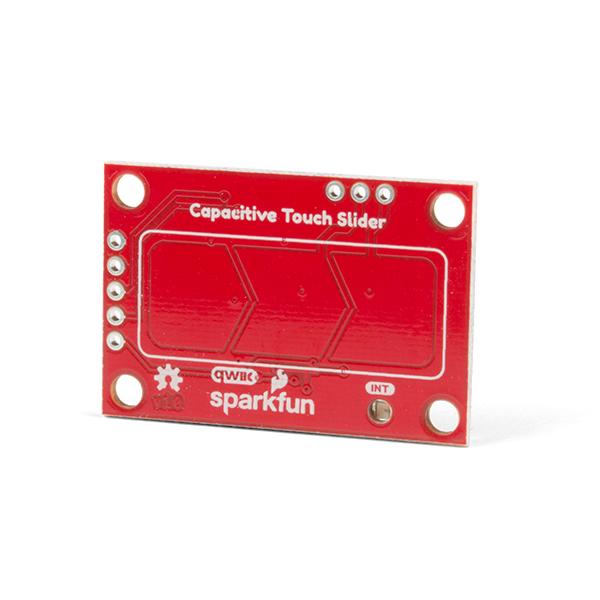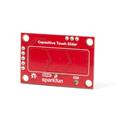SparkFun Capacitive Touch Slider - CAP1203 (Qwiic)

Description Links Attachments
The board features an arrow shape on the front, housing three separate capacitive touch pads. Sparkfun has also broken out the capacitive touch sensor lines as plated through-holes on the top of the board. These pins can be used to connect to your own capacitive touch pads. The CS1 pin connects to the left pad, the CS2 pin to the middle pad, and the CS3 pin to the right pad.
It should be noted that the I2C address of the CAP1203 is 0x28 and is hardware defined. A multiplexer/Mux is required to communicate to multiple CAP1203 sensors on a single bus. If you need to use more than one CAP1203 sensor, consider using the Qwiic Mux Breakout.
The SparkFun Qwiic connect system is an ecosystem of I2C sensors, actuators, shields, and cables that make prototyping faster and less prone to error. All Qwiic-enabled boards use a common 1mm pitch, 4-pin JST connector. This reduces the amount of required PCB space, and polarized connections mean you can’t hook it up wrong.
The Capacitive Touch Slider comes with a host of features including 3 unique capacitive touch inputs, an emulated slider, power button setting, programmable sensitivity, automatic recalibration, and a supply voltage operating range between 3.3V - 5V. To get started with the SparkFun Capacitive Touch Slider, refer to the Hookup Guide, Schematic, Eagle Files, Datasheet (CAP1203), Arduino Library, and GitHub Product Repo.
Properties
| Brand | Sparkfun |
| Model | SEN-15344 |
| More info | Capacitive Touch Slider (CAP1203) Hookup Guide - learn.sparkfun.com |
Customer questions
Customer Reviews
- In stock Sparkfun Copper Tape - Conductive Adhesive, 5mm - 15 meter € 7,75 View product
- In stock Sparkfun Teensy Stackable Header Kit (Extended) € 2,90 View product
- In stock Sparkfun Hobby Motor - Gear € 3,50 View product
- In stock Sparkfun Battery Holder 2xAA with Cover and Switch - JST Connector € 2,60 View product
- Sale In stock -72 % Sparkfun EasyDriver - Stepper Motor Driver € 21,25 € 6,05 View product
- In stock Sparkfun Thin Speaker - 4 Ohm, 2.5W, 28mm € 3,- View product
- In stock Sparkfun Alligator Clip with Pigtail (4 Pack) € 6,- View product
- In stock Sparkfun Toggle Switch € 3,30 View product
- In stock Sparkfun Clear Plastic Knob € 1,75 View product
- In stock Sparkfun Resistor 1K Ohm 1/4 Watt PTH - 20 pack (Thick Leads) € 2,15 View product
- In stock SparkFun Logic Level Converter - Bi-Directional € 5,15 View product
- In stock SparkFun Serial Basic Breakout - CH340G € 11,50 View product
- In stock SparkFun Audio Jack Breakout € 2,- View product
- In stock Sparkfun LED - Ultraviolet € 2,15 View product
- In stock Sparkfun Super Capacitor - 10F/2.5V € 6,25 View product










